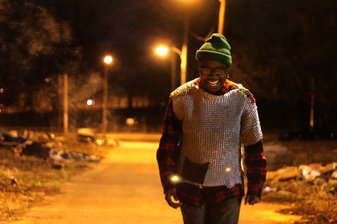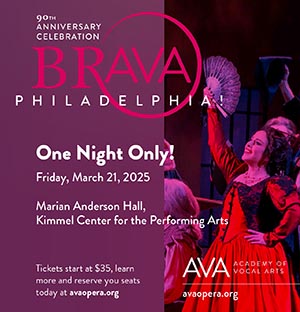Local out filmmaker Tiona McClodden is drawing upon her familial background and inventive storytelling for her ambitious new multimedia exhibition “Be Alarmed: The Black Americana Epic, Movement I — The Visions,” which is being presented by the Leeway Foundation at the Esther Klein Gallery through March 15.
“The Visions” is the first of four parts in McClodden’s series of mixed-media exhibitions using elements of film that first inspired her fascination with the medium and her desire to be a filmmaker.
“The project started from the idea to do a film that would have a different kind of experience, something you could walk through,” McClodden said. “But also a film that could span several decades and also be presented in different formats. The biggest inspiration was thinking about the way I came into being interested in cinema and my access to that as a kid. My early access to films was through a censored lens. I had to rely heavily on trailers and posters at the local VHS rental shop. That was my first view into a lot of films that at the time as a kid I couldn’t see. Part of my coming to this was I wanted to present a project that could be exhibited through those actual tools of film marketing. Aside from the content and the narrative, the actual exhibition is through trailers, scenes, posters and film stills. That’s how you come about the narrative as well as sculptural pieces that I have had positioned as film memorabilia pieces.”
McClodden said this project is a creative departure from her previous film projects.
“My prior work was documentaries. Now I’m moving into nonfiction/fiction hybrid work. This is where it gets most experimental for me,” she said. “The second part of the narrative comes from my own biography and my family’s biography starting from the early 1900s. I wanted to create this part that would deal with this element of this bio-mythography, taking into account real historical facts and mixing them in with these fictional elements that would tie my family’s history into a greater African-American history.” “The Visions” follows The Haint, a mute spirit who communicates through the use of film subtitles. Her primary communication is with The Heroine, played by McClodden.
McClodden said that while the narrative touches on elements of sexuality, it is more concerned with the narrative around her family history.
“Most of my work has dealt with a certain element of sexuality. In this case, the main character that I am focusing on is this spirit that is genderless that represents my maternal and paternal. There’s no sexuality focused on this but in terms of gender, there is a very transient space that I am looking at in terms of what a spirit who represents your mother and your father looks like. The way that I am positioning the body in the work kind of defines ideas of being easily read as male or female. That’s about as close as it gets. Other than that, it’s more historical and about my biographical narrative. I wanted to create a forum of Americana from my own hands, these sculptural portraits that I’m calling ‘Black Americana’ as a deconstructed idea of what the historical knowledge of Black Americana is, which is highly racist imagery of black Americans that were presented by a racist gaze. I wanted to challenge that idea and create these objects that are somewhat these portraits but they heavily deal with my familial lineage. Each sculpture/portrait deals with elements of my family.”
McClodden added that the “Be Alarmed” portion of the exhibition title was inspired by the years she spent living in North Philadelphia within earshot of Temple University Hospital.
“It was a different kind of experience and a little unnatural because of the amount of sirens and flashing lights that should signify some kind of alarm,” she said. “By my second year living over there, I kind of became desensitized to that. I always use that, the hospital and all the things around it — the police cars and the ambulances — as kind of the temperature gauge of Philadelphia as a city. In the summer it kind of gets intense. When the weather changes, I can sense when violence is in the city. I had this experience trying to deal with this element of being desensitized but being highly aware of what these things mean. All those flashing lights that used to come into my office, I would always have to remind myself that this should be something to be alarmed about. It stuck with me and I started to examine ideas of those lights and where they came from and how some of those lights, especially police lights, give off the same colors of the American flag. Sometimes Philadelphia has activities like the Fourth of July and sports events where they do fireworks when people hit homeruns. I would go to some of these events and it was hard to decipher when there was danger and when there wasn’t. So I just wanted to bring that element into the overall exploration of this black historical narrative. The title is this call to attention.”
McClodden hopes to complete and present the next three parts of this exhibition series over the next few years, but said viewers should be able to appreciate any and all parts of it on their own without having to see the others.
“The narrative is presented in trailer form, scene form and then press-kit stills,” she said. “If you did not see this first part, you should be able to have an isolated experience, which I am totally encouraging because the things that I am exploring and challenging is the idea of the trailer being able to exist and having its own narrative and you being able to put your own presumption of what it may be or what it isn’t. Then also there is creating these small intimate scenes that can exist as their own entities outside of the greater film in general. But of course, everything is in conversation with each other. There are various levels of the ways the audience can get it. If people think it’s pretty, I’m fine with that. If they just like one trailer or still, it’s fine. If they understand that point in the emotional narrative that I’m trying to push in that one segment, that’s fine. But for the folks that are hardcore into the idea of a nontraditional narrative, I think that they will enjoy the way that it is going to roll out.”
The Leeway Foundation and Breadboard present “Be Alarmed: The Black Americana Epic, Movement I — The Visions” through March 15 at Esther Klein Gallery at the Science Center in University City, 3600 Market St. For more information, call 215-966-6188 or visit www.tionam.com.

